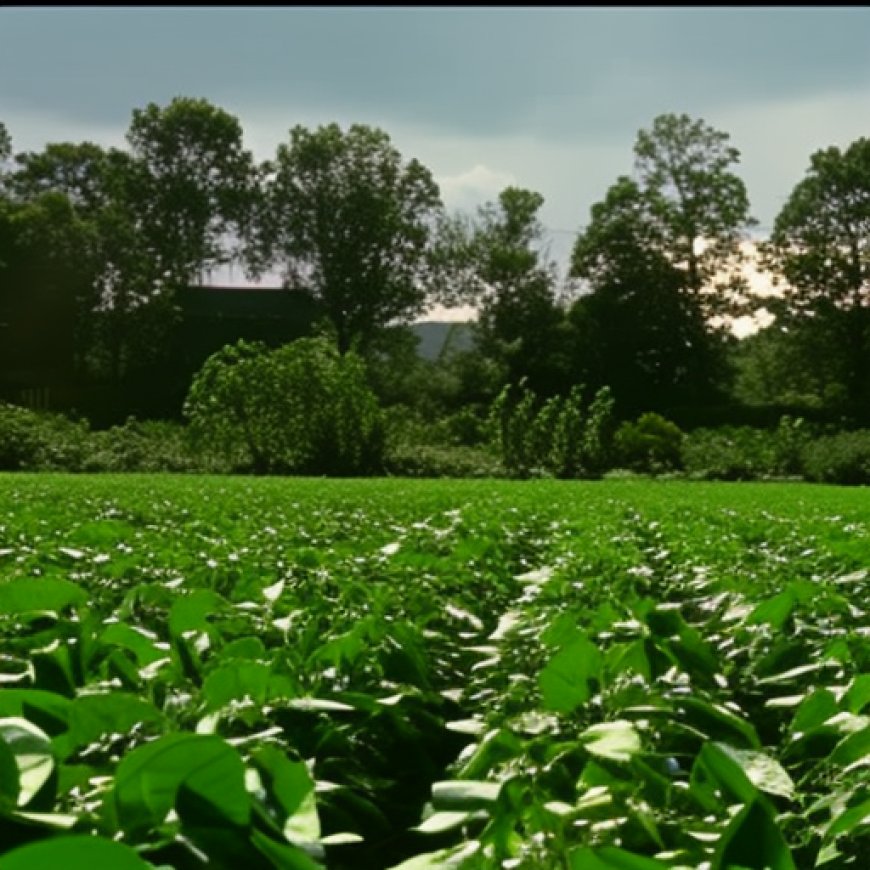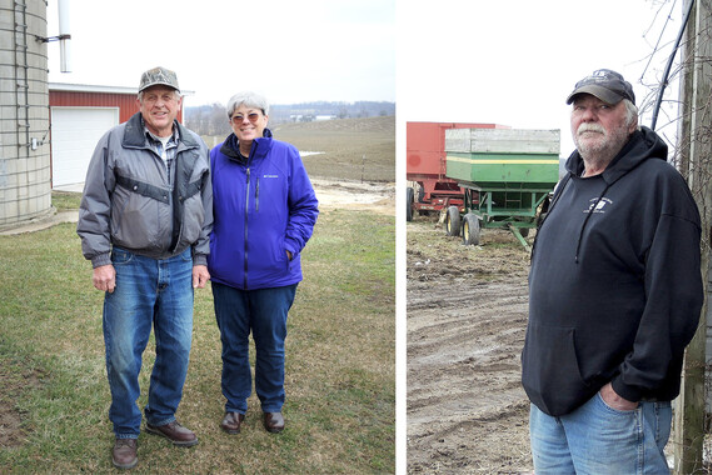How 2 farms preserved agricultural legacy amidst push for development
How 2 farms preserved agricultural legacy amidst push for development Second Wave Michigan


Owning a Family Farm in Michigan’s Fastest-Growing County

Owning a family farm in one of Michigan’s fastest-growing counties in the state means that there’s pressure to turn agricultural land into residential. It’s not the outcome Tom Holstege wanted for his 38-acre Michigan Centennial Farm in Zeeland Township.
“I was sure there for a while the last thing I ever planted here was going to be houses,” Holstege says. “Farmland is going so fast. I’m just really happy I got in the program so that I could preserve the farm. That’s my main goal. Not everything’s about money.”
After a five-year process, Holstege’s farm and the neighboring Jongekrijg farm have permanently protected the future of their land. Their decision to create agricultural conservation easements ensure 131 acres can be used to produce food and preserve rural character in perpetuity.
These farmers accomplished this through Ottawa County’s Purchase of Development Rights Program, which preserves farmland by purchasing development rights from an actively farmed property. Landowners are compensated for giving up the development potential, yet still own the land. The land must be used for agricultural purposes or remain in a natural state, even if it is sold or transferred.
Years-long Process
The decision by the Holstege and Jongekrijg families to sell their development rights underscores their commitment to local agricultural industries and land preservation, but it was not a decision made lightly. This effort started years ago, in 2019, when Holstege approached Ottawa County’s Department of Strategic Impact. Becky Huttenga, the county’s economic development coordinator, and Julie Lamer, farmland preservation analyst, worked with the farmers and local officials on the first steps in the process.
At that time, Zeeland Charter Township had not yet joined the Farmland Preservation Program, which meant his land didn’t qualify for the purchase of developmental rights.
Mark and Norma Jongekrijg, who own a neighboring farm, were interested in the program as well, and they began to attend township board meetings to encourage officials to adopt the resolution. They got their first win in this process when the resolution was passed, and then they began the work closer to home.
Next, both farms had to complete the preservation application. The Agricultural Preservation Board then reviewed and scored each application and made the yearly property selections. In back-to-back years, the two farmers scored high enough to be selected, and Ottawa County’s Huttenga and Lamer began working to secure funding for the easements.
No county money is spent to purchase developmental rights. The preservation of these properties is paid for through state and federal grants and the Ottawa County Farmland Preservation Program fund, which raises money through private donations, fundraising such as the annual “Farms are the Tapas” event, and landowner contributions.
The Jongekrijg preservation received funding from the Michigan Department of Agriculture and Rural Development and the Ottawa Conservation District’s Regional Conservation Partnership Program.
On Feb. 27 and March 19, almost five years after their owners’ first inquiries, these farms became permanently protected. While the land preservation process can take a lot of paperwork and time, five years is a blink compared to the time these lands have been farmed and the time they’ll continue to be farmed.
Deep Family Histories
A 38-acre certified Michigan Centennial Farm, the Holstege farm raises cattle and grows cash crops that stay largely within the local agricultural industry. The Jongekrijg farm is 92 acres of cash crops and cattle, and the family has implemented several conservation practices on their land.
“My grandfather on my dad’s side bought this property in 1937, and my parents purchased it from him in 1951, so it’s got about 13, 14 years to go to be a centennial farm,” Mark Jongekrijg says. “We’re working with my daughter and son-in-law, and eventually we’ll turn it over to them.
“I bought this farm from my mother five years ago, and it was always her goal to see it remain a family farm. I thought, ‘If I can do something that always keeps it that way, then that is my goal.’”
Preserving two neighboring properties creates additional benefits. It keeps farmable tracts of land close together, making the agricultural operation more efficient and economical by reducing the distance machinery must travel.
It can also create environmental benefits, such as reducing soil erosion, encouraging habitat restoration, and recharging groundwater.
How Much Does Agriculture Matter?
The Jongekrijg and Holstege families’ decisions to create permanent easements on their lands shows other farmers there are options to handle the challenges to succession and farmland conversion.
Ottawa County is an agricultural powerhouse and one of the fastest-growing counties in the state. The county, along with local units of government and other stakeholders, is working to balance the conflicting interests that come with urban growth and a plethora of successful industries in an agricultural area. One byproduct of population and industrial growth can be a decrease in farmland as owners succumb to development pressure. Municipalities must think of their master plan for the next two to three decades and how important agriculture is in their landscape.
The Ottawa County Farmland Preservation Program has worked hard to protect the agricultural legacy of Ottawa County by educating the community on the pressure farms are facing and the benefits of creating permanent agricultural easements.
So far, eight farms have preserved 697 acres through the Ottawa County Purchase of Development Rights Program. For eligible landowners interested in applying, the current application deadline is April 26.
Photos courtesy of Rich C. Lakeberg.
SDGs, Targets, and Indicators
-
SDG 2: Zero Hunger
- Target 2.4: By 2030, ensure sustainable food production systems and implement resilient agricultural practices that increase productivity and production, that help maintain ecosystems, that strengthen capacity for adaptation to climate change, extreme weather, drought, flooding, and other disasters, and that progressively improve land and soil quality.
- Indicator 2.4.1: Proportion of agricultural area under productive and sustainable agriculture.
- Indicator 2.4.2: Average income of small-scale food producers, by sex and indigenous status.
-
SDG 11: Sustainable Cities and Communities
- Target 11.3: By 2030, enhance inclusive and sustainable urbanization and capacity for participatory, integrated, and sustainable human settlement planning and management in all countries.
- Indicator 11.3.1: Ratio of land consumption rate to population growth rate.
- Indicator 11.3.2: Proportion of cities with a direct participation structure of civil society in urban planning and management that operate regularly and democratically.
-
SDG 15: Life on Land
- Target 15.1: By 2020, ensure the conservation, restoration, and sustainable use of terrestrial and inland freshwater ecosystems and their services, in particular forests, wetlands, mountains, and drylands, in line with obligations under international agreements.
- Indicator 15.1.1: Forest area as a proportion of total land area.
- Indicator 15.1.2: Proportion of important sites for terrestrial and freshwater biodiversity that are covered by protected areas, by ecosystem type.
Analysis
-
SDG 2: Zero Hunger
The article discusses the preservation of farmland to ensure the production of food. By protecting agricultural land, the farmers contribute to sustainable food production systems and resilient agricultural practices, which aligns with SDG 2.
-
SDG 11: Sustainable Cities and Communities
The article highlights the pressure to convert agricultural land into residential areas due to urban growth. By preserving farmland, the farmers contribute to sustainable urbanization and human settlement planning, which aligns with SDG 11.
-
SDG 15: Life on Land
The article mentions the environmental benefits of preserving farmland, such as reducing soil erosion, encouraging habitat restoration, and recharging groundwater. These actions contribute to the conservation and sustainable use of terrestrial ecosystems, aligning with SDG 15.
Table: SDGs, Targets, and Indicators
| SDGs | Targets | Indicators |
|---|---|---|
| SDG 2: Zero Hunger | Target 2.4: By 2030, ensure sustainable food production systems and implement resilient agricultural practices that increase productivity and production, that help maintain ecosystems, that strengthen capacity for adaptation to climate change, extreme weather, drought, flooding, and other disasters, and that progressively improve land and soil quality. |
|
| SDG 11: Sustainable Cities and Communities | Target 11.3: By 2030, enhance inclusive and sustainable urbanization and capacity for participatory, integrated, and sustainable human settlement planning and management in all countries. |
|
| SDG 15: Life on Land | Target 15.1: By 2020, ensure the conservation, restoration, and sustainable use of terrestrial and inland freshwater ecosystems and their services, in particular forests, wetlands, mountains, and drylands, in line with obligations under international agreements. |
|
Behold! This splendid article springs forth from the wellspring of knowledge, shaped by a wondrous proprietary AI technology that delved into a vast ocean of data, illuminating the path towards the Sustainable Development Goals. Remember that all rights are reserved by SDG Investors LLC, empowering us to champion progress together.
Source: secondwavemedia.com

Join us, as fellow seekers of change, on a transformative journey at https://sdgtalks.ai/welcome, where you can become a member and actively contribute to shaping a brighter future.







